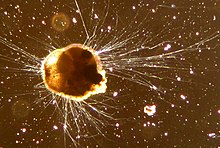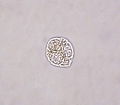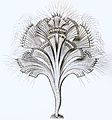| Revision as of 16:53, 17 December 2019 editCitation bot (talk | contribs)Bots5,430,452 editsm Add: bibcode, pmid, access-date, author-link. Removed parameters. | You can use this bot yourself. Report bugs here.| Activated by User:NessieVL | Category:Pages with citations using unsupported parameters | via #UCB_Category← Previous edit |
Revision as of 07:28, 12 February 2020 edit undoMaggibrisbin (talk | contribs)65 editsm noted that radiolarians are photosymbiotic in addition to foraminiferans and changed link in picture of acantharians (previous went to fungus, not the proper page for acanthrea)Tag: Visual editNext edit → |
| Line 15: |
Line 15: |
|
}} |
|
}} |
|
|
|
|
|
The '''Rhizaria''' are a species-rich supergroup of mostly ]<ref>{{cite web | url = http://www.palaeos.com/Eukarya/Units/Rhizaria/Rhizaria.html | year = 2004 | author = Christopher Taylor | title = Rhizaria | url-status = dead | archiveurl = https://web.archive.org/web/20090420034036/http://www.palaeos.com/Eukarya/Units/Rhizaria/Rhizaria.html | archivedate = 2009-04-20 }}</ref> ]s.<ref name="pmid15148395">{{cite journal |vauthors=Nikolaev SI, Berney C, Fahrni JF, etal |title=The twilight of Heliozoa and rise of Rhizaria, an emerging supergroup of amoeboid eukaryotes |journal=Proc. Natl. Acad. Sci. U.S.A. |volume=101 |issue=21 |pages=8066–71 |date=May 2004 |pmid=15148395 |pmc=419558 |doi=10.1073/pnas.0308602101 }}</ref> Except from the ] and three species in the genus ] in the phylum ], they are all non-photosynthethic, but many foraminifers have a symbiotic relationship with unicellular algae. A multicellular form, ''Guttulinopsis vulgaris'', a cellular ], has also been described.<ref>{{cite journal | url=http://www.cell.com/current-biology/abstract/S0960-9822(12)00413-7 | year = 2012 | author = Brown| title = Aggregative Multicellularity Evolved Independently in the Eukaryotic Supergroup Rhizaria |display-authors=etal | doi=10.1016/j.cub.2012.04.021 | volume=22 | issue = 12 | journal=Current Biology | pages=1123–1127 | pmid=22608512}}</ref> |
|
The '''Rhizaria''' are a species-rich supergroup of mostly ]<ref>{{cite web | url = http://www.palaeos.com/Eukarya/Units/Rhizaria/Rhizaria.html | year = 2004 | author = Christopher Taylor | title = Rhizaria | url-status = dead | archiveurl = https://web.archive.org/web/20090420034036/http://www.palaeos.com/Eukarya/Units/Rhizaria/Rhizaria.html | archivedate = 2009-04-20 }}</ref> ]s.<ref name="pmid15148395">{{cite journal |vauthors=Nikolaev SI, Berney C, Fahrni JF, etal |title=The twilight of Heliozoa and rise of Rhizaria, an emerging supergroup of amoeboid eukaryotes |journal=Proc. Natl. Acad. Sci. U.S.A. |volume=101 |issue=21 |pages=8066–71 |date=May 2004 |pmid=15148395 |pmc=419558 |doi=10.1073/pnas.0308602101 }}</ref> Except from the ] and three species in the genus ] in the phylum ], they are all non-photosynthethic, but many foraminifera and radiolaria have a symbiotic relationship with unicellular algae <ref>{{Cite journal|last=Gast|first=Rebecca J.|last2=Caron|first2=David A.|date=2001-10-01|title=Photosymbiotic associations in planktonic foraminifera and radiolaria|url=https://doi.org/10.1023/A:1012710909023|journal=Hydrobiologia|language=en|volume=461|issue=1|pages=1–7|doi=10.1023/A:1012710909023|issn=1573-5117}}</ref>. A multicellular form, ''Guttulinopsis vulgaris'', a cellular ], has also been described.<ref>{{cite journal | url=http://www.cell.com/current-biology/abstract/S0960-9822(12)00413-7 | year = 2012 | author = Brown| title = Aggregative Multicellularity Evolved Independently in the Eukaryotic Supergroup Rhizaria |display-authors=etal | doi=10.1016/j.cub.2012.04.021 | volume=22 | issue = 12 | journal=Current Biology | pages=1123–1127 | pmid=22608512}}</ref> |
|
This supergroup was proposed by ] in 2002. Being described mainly from ] sequences, they vary considerably in form, having no clear morphological distinctive characters (]), but for the most part they are ]s with filose, reticulose, or microtubule-supported ]s. Many produce shells or skeletons, which may be quite complex in structure, and these make up the vast majority of protozoan fossils. Nearly all have ] with tubular ]e. |
|
This supergroup was proposed by ] in 2002. Being described mainly from ] sequences, they vary considerably in form, having no clear morphological distinctive characters (]), but for the most part they are ]s with filose, reticulose, or microtubule-supported ]s. Many produce shells or skeletons, which may be quite complex in structure, and these make up the vast majority of protozoan fossils. Nearly all have ] with tubular ]e. |
|
|
|
|
| Line 120: |
Line 120: |
|
<gallery> |
|
<gallery> |
|
File:Cercomonas sp.jpg|''Cercomonas'' sp. (]: ] |
|
File:Cercomonas sp.jpg|''Cercomonas'' sp. (]: ] |
|
File:Ebria_tripartita.jpg|''Ebria'' sp. (Cercozoa: ]) |
|
File:Ebria tripartita.jpg|''Ebria'' sp. (Cercozoa: ]) |
|
File:Rhipidodendron splendidum.jpg|''Rhipidodendron'' sp. (Cercozoa: ]) |
|
File:Rhipidodendron splendidum.jpg|''Rhipidodendron'' sp. (Cercozoa: ]) |
|
File:Euglypha_sp.jpg|''Euglypha'' sp. (Cercozoa: ]) |
|
File:Euglypha sp.jpg|''Euglypha'' sp. (Cercozoa: ]) |
|
File:Haeckel Phaeodaria 1.jpg|Phaeodarians (Cercozoa: ]) |
|
File:Haeckel Phaeodaria 1.jpg|Phaeodarians (Cercozoa: ]) |
|
File:Clathrulina elegans - - Print - Iconographia Zoologica - Special Collections University of Amsterdam - UBAINV0274 113 04 0030.tif|'']'' (Cercozoa: Granofilosea: ]) |
|
File:Clathrulina elegans - - Print - Iconographia Zoologica - Special Collections University of Amsterdam - UBAINV0274 113 04 0030.tif|'']'' (Cercozoa: Granofilosea: ]) |
|
File:Chlorarachnion_reptans.jpg|'']'' sp. (Cercozoa: (]) |
|
File:Chlorarachnion reptans.jpg|'']'' sp. (Cercozoa: (]) |
|
File:Vampyrella lateritia.jpg|''Vampyrella'' sp. (Cercozoa: ]) |
|
File:Vampyrella lateritia.jpg|''Vampyrella'' sp. (Cercozoa: ]) |
|
File:Die_Gartenlaube_(1890)_b_083.jpg|'']'' (Cercozoa: ]) |
|
File:Die Gartenlaube (1890) b 083.jpg|'']'' (Cercozoa: ]) |
|
File:Powdery scab (Spongospora subterranea) of potatoes (1914) (14577838889).jpg|] (Cercozoa: ]) |
|
File:Powdery scab (Spongospora subterranea) of potatoes (1914) (14577838889).jpg|] (Cercozoa: ]) |
|
File:Foraminifères de Ngapali.jpg|Foraminiferans (]: ]) |
|
File:Foraminifères de Ngapali.jpg|Foraminiferans (]: ]) |
|
File:Mikrofoto.de-Radiolarien-3.jpg|]s (Retaria: ]) |
|
File:Mikrofoto.de-Radiolarien-3.jpg|]s (Retaria: ]) |
|
File:Haeckel_Acanthometra.jpg |]ns (Retaria: ]) |
|
File:Haeckel Acanthometra.jpg|] (Retaria: ]) |
|
</gallery> |
|
</gallery> |
|
</center> |
|
</center> |
A few other groups may be included in the Cercozoa, but some trees appear closer to the Foraminifera. These are the Phytomyxea and Ascetosporea, parasites of plants and animals, respectively, and the peculiar amoeba Gromia. The different groups of Rhizaria are considered close relatives based mainly on genetic similarities, and have been regarded as an extension of the Cercozoa. The name Rhizaria for the expanded group was introduced by Cavalier-Smith in 2002, who also included the centrohelids and Apusozoa.
In 2019, the Cercozoa were recognized as a basal Rhizaria group, as sister of the Retaria.

 Cercomonas sp. (Cercozoa: Cercomonadida
Cercomonas sp. (Cercozoa: Cercomonadida
 Ebria sp. (Cercozoa: Ebridea)
Ebria sp. (Cercozoa: Ebridea)
 Rhipidodendron sp. (Cercozoa: Spongomonadea)
Rhipidodendron sp. (Cercozoa: Spongomonadea)
 Euglypha sp. (Cercozoa: Euglyphida)
Euglypha sp. (Cercozoa: Euglyphida)
 Phaeodarians (Cercozoa: Phaeodarea)
Phaeodarians (Cercozoa: Phaeodarea)
 Clathrulina elegans (Cercozoa: Granofilosea: Desmothoracida)
Clathrulina elegans (Cercozoa: Granofilosea: Desmothoracida)
 Chlorarachnion sp. (Cercozoa: (Chlorarachniophyta)
Chlorarachnion sp. (Cercozoa: (Chlorarachniophyta)
 Vampyrella sp. (Cercozoa: Vampyrellidae)
Vampyrella sp. (Cercozoa: Vampyrellidae)
 Gromia (Cercozoa: Gromiidea)
Gromia (Cercozoa: Gromiidea)
 Powdery scab (Cercozoa: Plasmodiophorida)
Powdery scab (Cercozoa: Plasmodiophorida)
 Foraminiferans (Retaria: Foraminifera)
Foraminiferans (Retaria: Foraminifera)
 Polycystines (Retaria: Radiolaria)
Polycystines (Retaria: Radiolaria)
 Acantharians (Retaria: Radiolaria)
Acantharians (Retaria: Radiolaria)